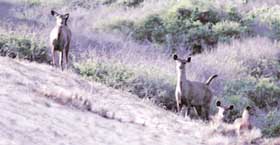






|
Part VI of our series on the environment with
Studio Times
Where the Sambhur roam
By Charith Pelpola
Pix by Nihal Fernando
By day it hides in coverts. At night it hunts
(or is hunted). It is a tall, slate-brown beast and its food is grass,
leaves and fruits. It haunts the Horton Plains, Wilpattu, Yala and just
for the heck of it, the long, sandy coastal beaches of Kumana and Yala.
It is a territory conscious, polygamous male chauvinist. But mating past,
it deserts wives and young to become once again a St. Simeon Stylites.
Sometimes it stays on, past rutting, to rout the cowardly leopard that
stalks its young."
- Robert Silva, from The Wild, the Free, the Beautiful
by Nihal Fernando.
The Sambhur of Horton Plains. Spirits that emerge with dusk and vanish
at dawn.
There are six, maybe seven in the herd. Their flight is urgent; feeling
the glare of the ghost cat on their backs. They have been wary of him throughout
the night, and the day affords no rest from their vigilance. There are
leopards here still - perhaps the most elusive representatives of this
island race - and their favoured quarry is sambhur. Sharing an ancient
association. The hunter and the hunted. Haunting the Plains and the close
concealing forest.
The leader of the herd rears his great head; the solid, six-pointed
antlers, so like the contorted branches of the withered trees. He has delivered
his harem safely to the cover of the trees. Testing the breeze for the
scents of strangers; his bristling body now betrays the form of a deer.
But heavier, stouter, stronger. His 500 pound bulk is almost bovine in
musculature, and now it heaves with a vigour more potent than ever.
 The
roars of the rutting sambhur stags ring wild throughout the vastness of
the Plains, and the great rising mountains of the Knuckles range. Roaming
the hidden, high country forests of Sri Lanka, where man has yet to place
a firm foot. Further south too, from the humid swamplands to the arid sand
dunes, they dwell. Here the largest of the island's stags are found, standing
at around 5 feet at the shoulder, and weighing in at around 600 pounds. The
roars of the rutting sambhur stags ring wild throughout the vastness of
the Plains, and the great rising mountains of the Knuckles range. Roaming
the hidden, high country forests of Sri Lanka, where man has yet to place
a firm foot. Further south too, from the humid swamplands to the arid sand
dunes, they dwell. Here the largest of the island's stags are found, standing
at around 5 feet at the shoulder, and weighing in at around 600 pounds.
The reputation earned by the sambhur for being the most cunning of all
deer spread their numbers into foreign fields. In 1875 a pair were introduced
into the coastal plains of New Zealand. Today herds range over 150 square
kilometres of the island. Although protected, they are subjected to licensed
hunting throughout the year.
In Sri Lanka, however their numbers remain uncertain. Sambhur lead secretive,
cautious lives, and because of their disposition, it is difficult to calculate
the size of the population. One fact however is certain. Much of their
habitat, the ancient woodlands and the remote hillsides, are disappearing
at the hands of the timber trade and the sweeping blade of chena cultivation.
whereby huge tracts of open land are systematically slashed and burned
to make way for farm crops. Poaching remains an invisible, unchecked menace
that infests every sanctuary and reserve.
These pressures may already have started to tell on the once prolific
herds. In Yala, the sambhur were a common sight; as abundant as their cousins
- the spotted deer. In recent years they seemed to have retreated further
away from the glare of men; affording a rare glimpse on some distant dune,
or a deserted scrubland water-hole.
In Horton Plains, the raging fires of wilful destruction have consumed
several hundred acres of the sambhur's habitat. Perhaps the time has come
for the sambhur to fear an enemy, far more menacing than his timeless adversary,
the leopard.
As the great stag oversees as a new generation of his kind, born into
a world far smaller than that of his forefathers, he may wonder, deep in
the restlessness of his wild heart, if the days of running are over. Better
to become ghosts, like the elephants and the bears, and the wilderness
that once was.
|




 The
roars of the rutting sambhur stags ring wild throughout the vastness of
the Plains, and the great rising mountains of the Knuckles range. Roaming
the hidden, high country forests of Sri Lanka, where man has yet to place
a firm foot. Further south too, from the humid swamplands to the arid sand
dunes, they dwell. Here the largest of the island's stags are found, standing
at around 5 feet at the shoulder, and weighing in at around 600 pounds.
The
roars of the rutting sambhur stags ring wild throughout the vastness of
the Plains, and the great rising mountains of the Knuckles range. Roaming
the hidden, high country forests of Sri Lanka, where man has yet to place
a firm foot. Further south too, from the humid swamplands to the arid sand
dunes, they dwell. Here the largest of the island's stags are found, standing
at around 5 feet at the shoulder, and weighing in at around 600 pounds.